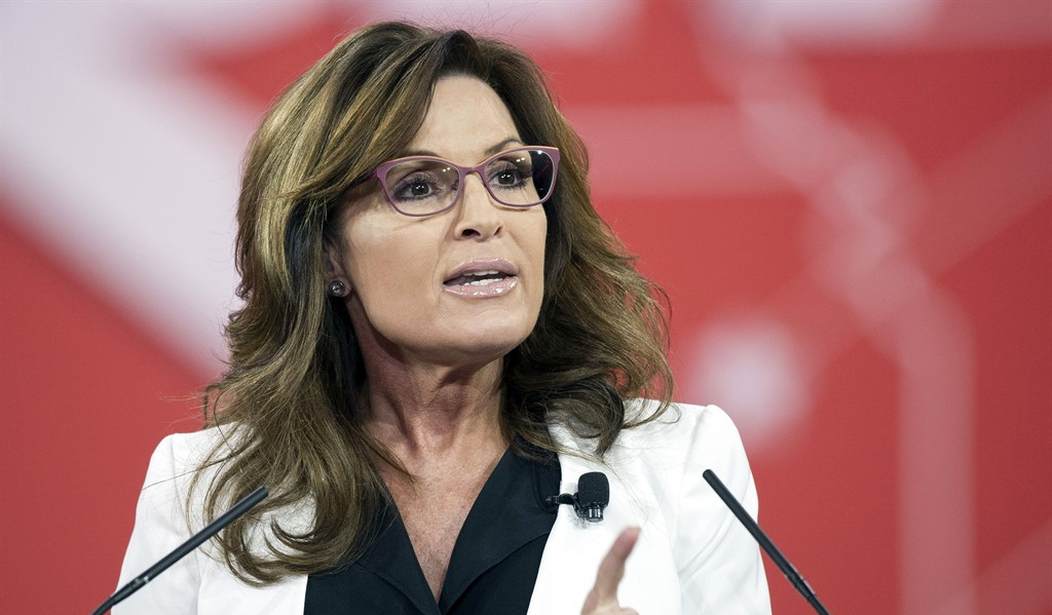It has been four and a half years since the NY Times published a false editorial about Sarah Palin and her connection to the Tucson shooting of Rep. Gabby Giffords. Now the case is finally going to trial next month:
The New York Times doesn’t often defend its journalistic practices before a jury. But later this month, the “Gray Lady” will indeed do so, as the influential newspaper has a trial date with Sarah Palin. Very much under the radar, jury selection in the 4-year-old case begins Jan. 24…
After conducting an unusual evidentiary hearing soon after Palin filed the lawsuit, U.S. District Court Judge Jed Rakoff quickly dismissed her complaint for a cognizable lack of actual malice. “Nowhere is political journalism so free, so robust, or perhaps so rowdy as in the United States,” wrote the judge in the order. “In the exercise of that freedom, mistakes will be made, some of which will be hurtful to others.”
But the 2nd Circuit Court of Appeals concluded Rakoff was too rash, and after the complaint was revived, Rakoff came to a new conclusion when denying summary judgment. The judge said that while there may be considerable evidence that Bennet simply drew an innocent inference, taken in a light most favorable to Palin, “the evidence shows Bennet came up with an angle for the Editorial, ignored the articles brought to his attention that were inconsistent with his angle … and ultimately made the point he set out to make in reckless disregard of the truth.”
Though jury selection will begin later this month, the actual trial is set to begin on February 1. In case you’ve forgotten what all of this was about, here’s the claim the Times published in an editorial about the Alexandria baseball shooting back in 2017 [emphasis added]:
In 2011, when Jared Lee Loughner opened fire in a supermarket parking lot, grievously wounding Representative Gabby Giffords and killing six people, including a 9-year-old girl, the link to political incitement was clear. Before the shooting, Sarah Palin’s political action committee circulated a map of targeted electoral districts that put Ms. Giffords and 19 other Democrats under stylized cross hairs.
Conservatives and right-wing media were quick on Wednesday to demand forceful condemnation of hate speech and crimes by anti-Trump liberals. They’re right. Though there’s no sign of incitement as direct as in the Giffords attack, liberals should of course hold themselves to the same standard of decency that they ask of the right.
Those paragraphs were like a window into an alternate universe. The editorial was arguing that the Alexandria baseball shooting, in which a deranged Bernie Sanders supporter who frequently posted anti-Trump messages on social media nearly killed Steve Scalise and others, was similar to the Gabby Giffords shooting in Tucson years earlier but without the clear connection to political incitement.
Except that by the point the Times published this mess, the Giffords shooting had happened more than six years earlier and anyone who knew anything about the topic knew that there was never any connection to Sarah Palin or the district targeting map. In fact, Jared Lee Loughner’s fixation on Giffords went back years before the shooting, even before Sarah Palin was a figure on the national scene.
Palin indicated the day that editorial was published that she might sue the Times and two weeks later she followed through. Meanwhile, the Times made corrections to the editorial but claimed those changes didn’t undercut their larger point. That was false since the idea that the baseball shooting was part of a “familiar pattern” was one of the major points of the original piece. Indeed, the corrected editorial still contains this line: “Not all the details are known yet about what happened in Virginia, but a sickeningly familiar pattern is emerging in the assault…” As I wrote at the time, there were only two data points in this “familiar pattern” and the other one was Sarah Palin’s connection to the Tucson shooting. Once you removed that false claim, there was no pattern.
The Times has argued ever since that the false claims in the original article were an innocent mistake. But a detailed timeline of how the editorial came to be suggests this was closer to reckless disregard for the truth. The key point is that the final author of the piece, James Bennett, added the false claims about Palin to an earlier draft by Elizabeth Williamson even though he admitted both before and after writing it that he didn’t know what the truth was about the Tucson shooting:
Sometime shortly before midnight, Bennet sent an email to Williamson: “Are you up? The right is coming after us…” He must not have slept much that night because the following morning he had sent an email to his team at 5:08 am: “Hey guys — We’re taking a lot of criticism for saying that the attack on Giffords was in any way connected to incitement.… I don’t know what the truth is here, but we may have relied too heavily on our early editorials and other early coverage of that attack. If so, I’m very sorry for my own failure on this yesterday. … I’d like to get to the bottom of this as quickly as possible this morning and correct the piece if needed.”
So if you’re following this closely, Bennet went from not knowing what was true in the early afternoon, to knowing in the evening that Palin was responsible as he rewrote the editorial, and then back to not knowing the following morning. The Times’ lawyers want to say that this proves it was all a mistake, i.e. he didn’t know he was wrong. But how can that be so if he stated he didn’t know the truth before the rewrite? Once he’d admitted that, wasn’t it his responsibility to research the connection before stating categorically that it existed? But Bennet claimed in his deposition that he never looked at any of the links provided to him, including the one Williamson had buried in her draft.
Based on the emails, I don’t know that Palin can prove Bennett intentionally wrote claims about her and the Tucson shooting which he knew were false. To be clear, Bennett could be lying and in fact has every reason to lie in this circumstance. Admitting he knew the truth and wrote the false editorial anyway would lead to a very large judgment against the NY Times. But proving he knew seems like it would be very hard to do.
However, Palin only has to prove that Bennett acted with reckless disregard for the truth and that seems achievable. Not reading the links your colleagues sent you about the truth of the matter you asked them about seems like reckless disregard. Literally, all he had to do was a two minute Google search of the Times’ own site on this long-since settled question. Alternatively, he could have removed the confident prose connecting Palin to a mass murder on the grounds that he didn’t know there was a connection. What Bennett definitely did by his own admission, choosing not to look at the facts and then making false claims as to the facts, seems pretty reckless.
Finally, there’s one other story about the preparations for the coming trial. Palin’s attorneys have asked that a series of proposed exhibits not be shown during the trial, including her performance on The Masked Singer.
In a court filing in the Manhattan federal suit Monday, the former GOP vice presidential candidate listed a number of proposed exhibits she wants hidden from the jury because they could cause “unfair prejudice and confusion,” among other issues.
Among the exhibits listed are “Masked Singer Video – Dancing and Rapping” and “Masked Singer Video – Reveal.”
The list includes dozens of other proposed exhibits that Palin doesn’t want a jury to see unless a judge signs off on their admissibility beforehand.
The NY Post says it’s not clear why the NY Times would want to introduce any of this but I don’t think it’s that hard to figure out. The Times is going to argue that Palin was a very public figure and if they can use The Masked Singer reveal video to do it, all the better. Jonathan Turley calls it a cheap shot:
This would seem an easy example of evidence having a greater likelihood to produce unfair prejudice and confusing the issues before the jury. It is frankly a cheap shot unworthy of any major publication. It is entirely irrelevant to whether the Times acted with knowing falsity or reckless disregard of the truth in attacking Palin.
Frankly this whole thing has been a cheap shot since it started in 2011. Bennett’s 2017 editorial was another cheap shot relying on the false claims from years earlier. Now the Times is hoping to defend itself from its own reckless disregard for the truth using another cheap shot at Palin. When it comes to the treatment of conservatives by outlets like the Times, it’s cheap shots all the way down.
This clip of Joe Rogan talking about the mainstream media seems appropriate.
Tell me Rohan’s media criticism in this clip isn’t penetrating and accurate. And in under a minute’s worth of time. https://t.co/NiTowN2qsC
— Jeff B. is *BOX OFFICE POISON* (@EsotericCD) January 13, 2022








Join the conversation as a VIP Member